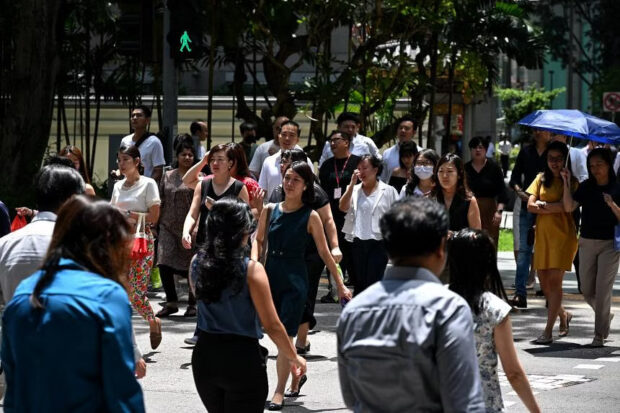Job vacancies in Singapore up even as unemployment rate rises: report

There were 81,900 vacancies recorded in March 2024, up from 79,800 in December 2023. ST PHOTO: KUA CHEE SIONG
SINGAPORE – The number of job vacancies in Singapore increased in March 2024 even as the number of people unemployed inched up, as a mixed picture emerges from the latest quarterly report on the labor market.
Still, the labor market remains tight as there are more vacancies available than there are job seekers, the Ministry of Manpower (MOM) said in its report of finalized labor market data for the first quarter of 2024.
There were 81,900 vacancies recorded in March 2024, up from 79,800 in December 2023.
“This reflects the improved economic prospects in 2024,” MOM said.
Job vacancies in growth sectors – which are associated with higher productivity and pay – formed nearly one-third of all job vacancies.
They include health and social services, information and communications, professional services, and financial and insurance services.
Although the number of job vacancies rose, the ratio of job vacancies to unemployed people declined from 1.74 in December 2023 to 1.56 in March 2024, owing to a slight increase in the number of unemployed people, MOM said.
Meanwhile, retrenchments declined for the second consecutive quarter, from 3,460 in the fourth quarter of 2023 to 3,030 in the first quarter of 2024.
The incidence of retrenchment in the first quarter of 2024 reached 1.3 per 1,000 employees, down from 1.9 per 1,000 employees in the third quarter of 2023.
Restructuring
MOM said this was lower than pre-pandemic levels, as the quarterly average for 2015 to 2019 was 1.7 per 1,000 employees.
The ministry said the decline was driven by the drop in retrenchment numbers from outward-oriented sectors such as wholesale trade and electronics manufacturing.
For wholesale trade, retrenchment numbers shrank to 330 from 510 between the fourth quarter of 2023 and the first quarter of 2024.
Electronics manufacturing saw a decline to 190 from 540 over the same period.
Though the number of retrenchments in information and communications also declined from 620 to 580 over the same period, the level remained elevated compared with other industries, MOM said.
Business reorganization or restructuring continued to be the most common reason for retrenchment cited by firms.
Retrenchments attributed to concerns of a recession or downturn, and high costs, have declined.
But in its report, MOM also noted that the rate of retrenched workers who were able to re-enter employment six months after retrenchment dipped slightly to 59.4 percent, from 61.5 percent in the previous quarter.
The decline in re-entry rate was observed in information and communications, financial and insurance services, and professional services.
But MOM said more than half of those retrenched in these sectors were still able to find new jobs within six months.
Nevertheless, the resident long-term unemployment rate inched up from 0.7 percent in December 2023 to 0.8 percent in March 2024, though MOM said the figure remains low.
Unemployment rate
The increase in the resident long-term unemployment rate was driven by those aged below 30, which rose from 1 percent to 1.2 percent, and those 60 and over, which grew from 0.7 percent to 0.9 percent.
“For residents aged below 30, the increase in long-term unemployment rate could be due to individuals holding out for a better job or taking time to explore different career options post-graduation,” MOM said.
“For residents aged 60 and over, the long-term unemployment rate remained comparable to pre-pandemic levels of 0.8 percent.”
The overall unemployment rate reached 2.1 percent, while the resident unemployment rate was 3 percent, and that for Singaporeans was 3.1 percent. “Residents” refers to Singaporeans and permanent residents.
This is slightly higher than in previous months, but MOM said the rate remained within the range observed during non-recessionary periods.
The report also found that employment growth slowed, but all the growth came from Singaporeans and permanent residents, as the number of employed foreigners fell by 800, the first decline since the third quarter of 2021.
Among residents, the increase in employment was driven by financial and insurance services, public administration, health and social services, administrative and support services, and education.
However, resident employment continued to decline in lower-paying sectors such as retail trade and food and beverage services after seasonal increases in the fourth quarter of 2023.
Foreign workers
MOM said the decline in the employment of foreigners was driven mainly by the construction and manufacturing sectors, which had seen positive employment growth for the past two years, as the lower foreign worker quota for the construction and process sectors came into effect.
READ: Singapore tightens rules for hiring foreign professionals
S Pass holders saw negative growth in the first quarter of 2024, following the 2023 increase in S Pass qualifying salaries and levies, MOM noted.
Although the number of work permit and other pass holders rose, this has slowed significantly from the previous quarter.
Employment Pass (EP) holders also saw negative growth, registering their first decline since late 2021.
Sectors that saw a decline in the number of EP holders included information and communications, and professional services, which continued to face global headwinds, the ministry said.
However, the number of EP holders grew in other sectors such as wholesale trade and transport and storage.
Overall EP applications have picked up in tandem with the improving economic outlook, MOM said.